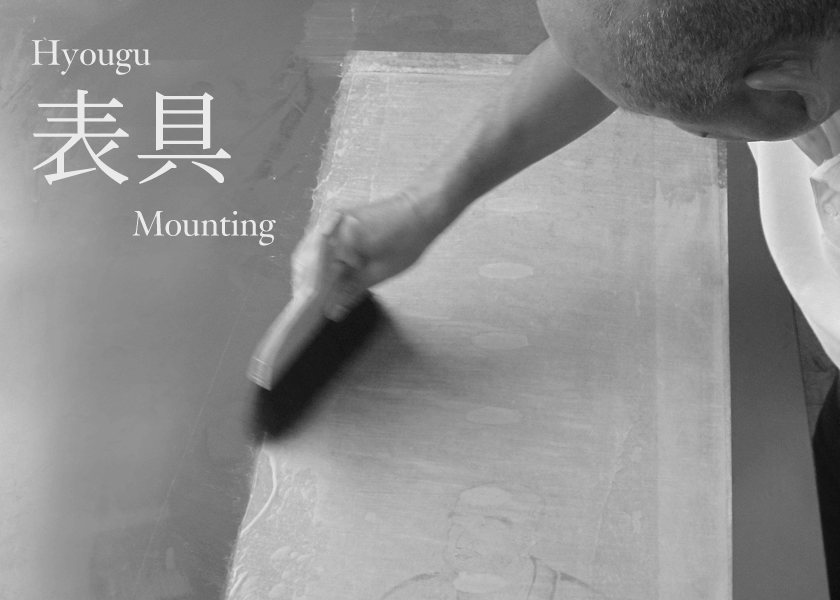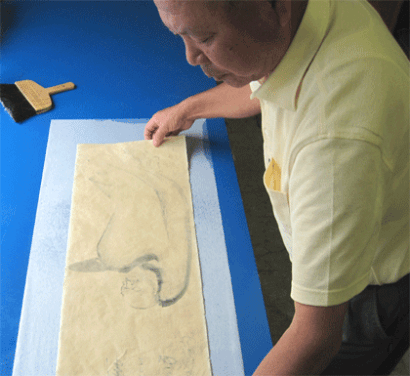Lesson
News / Blog
Other Menus
About Hyougu

Hyougu
Since many of the traditional paintings of the East are rendered on fragile materials, such as silk and paper, they need reinforcement them to make them suitable for appreciation and preservation. With the introduction of Chinese and Korean painting techniques to Japan, techniques for mounting were also introduced, transmitted, and developed. Mounting techniques embrace the wisdom of our predecessors, regarding decoration, reinforcement, and the preservation of paintings. Traditional paintings of the East, because of deterioration of the paintings and mounting, have been preserved until the present day by means of regular restoration performed every 100 to 200 years. Thus, techniques of mounting and restoration are indispensable in preserving these works of art.
Hyougushi
Mounting is called “hyougu,” which means the work of making and repairing “makimono” (scrolls), “kakejiku” (hanging scrolls), and furnishings made of paper and wood, such as “fusuma” (sliding doors) and “byoubu” (folding screens). The mounting of a calligraphic work or painting on a kakejiku is most commonly called “jikusou,” and putting the work in a frame is called “gakusou.”
The “hyougushi” is a craftsman who makes and repairs a kakejiku, fusuma, and byoubu, or fixes a work in the frame with various materials: for example paste, Japanese paper, water, and fabric. These operations are very difficult, so he must have specialized knowledge, a lot of experience, and a high degree of skill. In addition, extreme caution is always necessary when working with precious artworks. A sense for choosing materials and sensitivity to colors are essential, too.

Hyougu (Jikusou)

Hyougushi (Scroll Mounter)
History of Mounting
Mountings date back to the Heian Court period (857-1185 A. D.) when Esoteric Buddhism was being introduced into Japan from China. Paintings of the Buddha and other Buddhist saints which were used as items of reverence in the dissemination of the religion throughout the country, along with kakeiiku (hanging scrolls) or Scroll paintings called mandala, which were symbolic depictions of the Buddhist cosmos, formed the basic models for mountings.
From the Kamakura into the Muromachi Period the scroll paintings called shoga (actually they were pictures painted alongside some capsule Buddhist Phrase) of the Zen school became widespread. Itwas during this period that the tokonoma or alcove became established as part of the unique architecture of the Japanese room. It was their use in the tokonoma that the form of the mountings came into completion. They were used as decorations and frequently changed to harmonize with the season or the occasion.
The Edo Period (1603-1868) saw the appearance of chagake hyougu which were mountings hung in the tea-rooms and served as appropriate conversation pieces during the tea-ceremony. The subject matter of the paintings were either calligraphic, called bokuseki, or Southern Chinese style landscapes painted by famous men of letters. These were called bunjinga. Other types of mountings developed along with the popularization of Buddhism and the tea-ceremony becoming a part of the culture of all levels of the society.
Today, with the Westernization of Japanese homes, mountings are no longer found only in the tokonoma. We can now find them hanging on almost any wall inside picture frames or serying as dividers called tsuitate, to set off certain areas or parts of a room.
Mounting Materials and Techniques
The basic materials used in making mountings are paper and cloth, in addition to some sort of adhesive, and wood. The most important process in the making of mountings is the ancient technique of backing or mounting the painting onto either a piece of cloth or onto some other paper with an adhesive. Lining up and fixing the two pieces requires a highly skilled hand. Even though the same person may use the same materials and the same techniques, the consistency of the adhesive or a slight difference in humidity could produce a totally different result. Therefore, painstaking care is an essential element. The cloth used for the backing and the paper on which we have the painting are cut and then joined together. The work of fitting together, adhering, and drying section by section is repeated over and over exposing the piece to various temperatures.
Finally, horizontal rods are attached to the top and bottom and the mounting is complete.
The Shape of Mountings
Mountings do not exist as independent pieces,that is, as standardized frames. They are part of the painting or calligraphy itself and together form one art piece. A well-balanced mounting is one in which the backing paper or cloth best brings out the qualities of the painting or calligra phy. When preparing mountings, the paper or cloth used as a binding surrounding the picture gives overall shape and proper tone of color to the piece. There is a detailed procedure for deciding the shape, the measurements, the way of putting paper and cloth together, and even the color of the binding paper itself.
Finally, when not in use, in order to preserve and protect it from damage, the mounting should be rolled up and kept in the paulownia wood box made especially for this purpose.
As the materials for the mounting must harmonize with the picture being mounted, it is natural for there to be various shapes depending on the size, use, or subject matter of the painting. Chagake hyougu which are closely associated with the tea-ceremony and the unique mountings used for decorative purposes in Western style rooms serve as good examples of the breadth in the variety of mountings.

